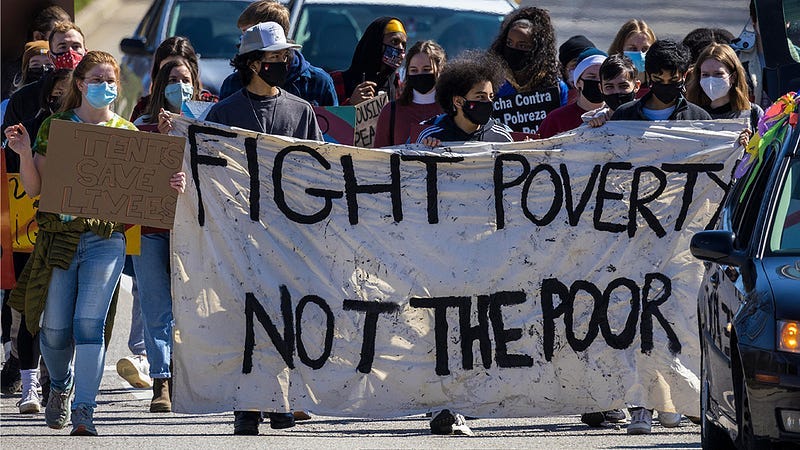Consider two economies. In the first, GDP grows at 3% annually, corporate profits reach record highs, and the stock market surges to new peaks. Yet median wages decline in real terms, household debt climbs to crisis levels, and half the population cannot cover a $400 emergency. In the second economy, GDP growth stalls at 1%, corporate earnings are modest, but median wages rise, household savings increase, and financial security improves for working families.
Which economy would you choose to live in?
We are living in the first economy. The United States is not in a recession by any official measure. GDP grew 3% last year. Unemployment sits at 4.1%. The S&P 500 has reached record highs. By the metrics economists and policymakers use to assess economic health, the American economy is robust.
Meanwhile, credit card delinquency rates have reached levels not seen since the Great Recession. Personal savings have collapsed to 2008 financial crisis lows. Nearly half of American households have zero retirement savings. Thirty-seven percent cannot cover a $400 emergency expense. By every measure that reflects whether ordinary people can afford housing, healthcare, food, and basic financial security, the economy is in crisis.
The problem is not that we are missing a recession. The metrics themselves measure the wrong things entirely.
A recession, by standard definition, is a significant decline in economic activity lasting more than a few months, typically identified by two consecutive quarters of negative GDP growth. This framework measures aggregate output and total employment. It asks whether the economy is producing less and whether fewer people are working.
These are not the questions that matter to household wellbeing. Consider what an economic system should optimize for. If the answer is human flourishing, then the relevant questions are different. Can people working full-time afford basic necessities? Can they save for emergencies? Can they retire with dignity? Is economic growth translating to improved living standards for the majority?
Our current metrics were not designed to answer these questions. They were designed to measure something else entirely.
Credit card delinquency hit 3.05% in Q1 2025, approaching Great Recession peaks and marking some of the highest levels in over a decade. This rate began climbing in late 2021 and has continued rising for over four years. The average household carrying credit card debt now pays over $2,300 annually just in interest at rates averaging 21–22%. These households borrowed to maintain living standards during inflation. Now they cannot service that debt even with nominal wage gains.
The bottom 20% of earners spend 62.7% of income on rent and utilities, leaving just $476 monthly for everything else. Food, transportation, healthcare, childcare, debt payments, emergencies. Nearly half of all renter households now spend over 30% of income on housing. Since 2001, median rents rose 21% inflation-adjusted while renter incomes grew just 2%.
Currently, food insecurity affects 47.4 million Americans. Nationally, 56% of food-insecure households had at least one adult employed full-time in 2023. Having a job provides no meaningful protection against hunger. Working poverty affects 6.4 million Americans who spent at least half the year employed but still fell below the poverty line, including 2.9 million full-time workers.
Strong GDP growth and record stock markets fail to improve these conditions because of who captures economic gains. The top 10% own 93% of all stock market wealth. The bottom 50% owns just 1%. When the S&P 500 gains 23%, the top 1% captures roughly 54% of those gains while the bottom half receives 1%. Since 1979, productivity grew 64.6% while median hourly pay grew just 17.5%. St. Louis Federal Reserve analysis found that 76% of recent profit growth went to shareholders through dividends while worker compensation as a share of national income remained flat.
The official unemployment rate counts only those actively seeking work in the past four weeks. It systematically excludes discouraged workers and those working part-time who need full-time employment. The broader U-6 measure reveals 86% more labor market distress than the headline number. GDP rises when billionaires increase spending or corporations boost investment, even as median household income declines.
The metrics we use to define economic health were not constructed by accident. They were designed to measure what matters to those who own capital. Aggregate output, corporate profits, and asset values. Whether working people can afford housing or healthcare is simply not what these frameworks were built to track.
The people who push “recession” and “economic strength” narratives are the same people whose wealth depends on corporate earnings and stock valuations. From their vantage point, an economy where GDP grows 3% while median wages fall is functioning perfectly well. It’s delivering exactly what it was designed to deliver.
The result is a measurement framework that treats household financial collapse as irrelevant to economic health. When half of American households spend over 30% of income on housing, this does not register as an economic problem in official statistics. When 37% cannot cover a $400 emergency, this does not factor into whether the economy is “strong.” When real wages decline while productivity surges, the system is working as intended.
By every measure that matters to household financial survival, most Americans are experiencing crisis conditions in 2025. “Recession” measures economic health the way a corporate balance sheet does. It tracks output and employment without regard to distribution, quality, or whether households can stay solvent. It tells you whether the economy is producing more, not whether that production translates to public wellbeing.
The disconnect between strong aggregate indicators and widespread household distress is the predictable result of a measurement framework designed to track capital returns rather than living standards. When economic gains flow overwhelmingly to those who already own most assets, GDP and stock markets can hit records while working people cannot afford rent, healthcare, or food.
Our economic framework was not built to measure your wellbeing. It was built to ignore it.
What do we do with this information? To start with, we know who not to trust. When someone cites GDP growth or the stock market to tell you the economy is strong, you know they are either ignorant of how these metrics function or they don’t care about the needs of the 99%. The metrics used by the oligarch media will not change because they want to convince people that their empty bank accounts don’t matter because Elon bought a new yacht and that’s good for GDP. But we no longer have to accept their framing of reality, and the more we can loudly and persistently shame its use, the more people will wake up.
If you found this article worthwhile, check out my book
Conservatism: America’s Empathy Disorder
https://a.co/d/6d4b1uH
References
Abdelrahman, H., & Oliveira, L. E. (2024, May 3). Pandemic savings are gone: What’s next for U.S. consumers? Federal Reserve Bank of San Francisco Economic Letter (blog). https://www.frbsf.org/research-and-insights/blog/sf-fed-blog/2024/05/03/pandemic-savings-are-gone-whats-next-for-us-consumers/
Administrative Office of the U.S. Courts. (2025, July 31). Bankruptcy filings rise 11.5 percent over previous year. https://www.uscourts.gov/data-news/judiciary-news/2025/07/31/bankruptcy-filings-rise-115-percent-over-previous-year
Aladangady, A., Bricker, J., Chang, A. C., Goodman, S., Krimmel, J., Moore, K. B., Reber, S., Henriques Volz, A., & Windle, R. A. (2023, October). Changes in U.S. family finances from 2019 to 2022: Evidence from the Survey of Consumer Finances. Federal Reserve Bulletin. Board of Governors of the Federal Reserve System. https://doi.org/10.17016/8799
Board of Governors of the Federal Reserve System. (2025, May 28). Report on the economic well-being of U.S. households in 2024. https://www.federalreserve.gov/publications/files/2024-report-economic-well-being-us-households-202505.pdf
Board of Governors of the Federal Reserve System (US). Distributional Financial Accounts. Federal Reserve Bank of St. Louis, FRED. https://www.federalreserve.gov/releases/z1/dataviz/dfa/
Board of Governors of the Federal Reserve System (US). Share of net worth held by the bottom 50% (1st to 50th wealth percentiles) [WFRBSB50215]. Federal Reserve Bank of St. Louis, FRED. https://fred.stlouisfed.org/series/WFRBSB50215
Capital Area Food Bank & NORC at the University of Chicago. (2024). Hunger Report 2024. https://hunger-report.capitalareafoodbank.org/report-2024/
Child Care Aware of America. (2025, May). Child Care in America: 2024 price & supply. https://www.childcareaware.org/price-landscape24/
Claxton, G., Rae, M., et al. (2024, October 9). 2024 Employer health benefits survey. Kaiser Family Foundation. https://www.kff.org/health-costs/report/2024-employer-health-benefits-survey/
Collins, C. (2024, January). The richest 1 percent own a greater share of the stock market than ever before. Inequality.org. Institute for Policy Studies. https://inequality.org/article/stock-ownership-concentration/
Collins, S. R., et al. (2023, October). Paying for it: How health care costs and medical debt are making Americans sicker and poorer — 2023 health care affordability survey. The Commonwealth Fund. https://www.commonwealthfund.org/publications/surveys/2023/oct/paying-for-it-costs-debt-americans-sicker-poorer-2023-affordability-survey
Consumer Financial Protection Bureau. (2022, September). Buy Now, Pay Later: Market trends and consumer impacts. https://files.consumerfinance.gov/f/documents/cfpb_buy-now-pay-later-market-trends-consumer-impacts_report_2022-09.pdf
Consumer Financial Protection Bureau. (2025, January 13). CFPB research reveals heavy buy now, pay later use among borrowers with high credit balances and multiple pay-in-four loans. https://www.consumerfinance.gov/about-us/newsroom/cfpb-research-reveals-heavy-buy-now-pay-later-use-among-borrowers-with-high-credit-balances-and-multiple-pay-in-four-loans/
Dynan, K., & Sheiner, L. (2018, August). GDP as a measure of economic well-being (Hutchins Center Working Paper #43). The Brookings Institution. https://www.brookings.edu/wp-content/uploads/2018/08/WP43-8.23.18.pdf
Economic Policy Institute. (n.d.). The productivity–pay gap. https://www.epi.org/productivity-pay-gap/
Federal Reserve Bank of New York, Center for Microeconomic Data. (2025, February 13). Quarterly report on household debt and credit 2024:Q4. https://www.newyorkfed.org/medialibrary/interactives/householdcredit/data/pdf/HHDC_2024Q4
Federal Reserve Bank of San Francisco. (2024). Pandemic-era excess savings [Data set]. https://www.frbsf.org/research-and-insights/data-and-indicators/pandemic-era-excess-savings/
Federal Reserve Bank of St. Louis. (2025, May). The broad, continuing rise in delinquent U.S. credit card debt revisited. On the Economy (blog). https://www.stlouisfed.org/on-the-economy/2025/may/broad-continuing-rise-delinquent-us-credit-card-debt-revisited
Feeding America. (2024, November 12). More than 50 million people turned to hunger relief programs in 2023 [Press release]. https://www.feedingamerica.org/about-us/press-room/charitable-food-assistance-2023
Joint Center for Housing Studies of Harvard University. (2024, January 25). America’s rental housing 2024. https://www.jchs.harvard.edu/americas-rental-housing-2024
Larrimore, J., & Schuetz, J. (2017, December 22). Assessing the severity of rent burden on low-income families. FEDS Notes. Board of Governors of the Federal Reserve System. https://www.federalreserve.gov/econres/notes/feds-notes/assessing-the-severity-of-rent-burden-on-low-income-families-20171222.html
Marto, R. (2025, April 21). What’s driving the surge in U.S. corporate profits? Federal Reserve Bank of St. Louis On the Economy (blog). https://www.stlouisfed.org/on-the-economy/2025/apr/whats-driving-surge-us-corporate-profits
Mattingly, A., & Watson, A. (2024). A look at jobs paying less than $15.00 per hour. Spotlight on Statistics. U.S. Bureau of Labor Statistics. https://www.bls.gov/spotlight/2024/a-look-at-jobs-paying-less-than-15-00-per-hour/home.htm
Mateyka, P. J., & Yoo, J. (2023, March). Share of income needed to pay rent increased the most for low-income households from 2019 to 2021. America Counts: Stories. U.S. Census Bureau. https://www.census.gov/library/stories/2023/03/low-income-renters-spent-larger-share-of-income-on-rent.html
NerdWallet. (2024). 2024 American household credit card debt study. https://www.nerdwallet.com/article/credit-cards/2024-american-household-credit-card-debt-study
Nolan, B., Roser, M., & Thewissen, S. (2019). GDP per capita versus median household income: What gives rise to the divergence over time? Review of Income and Wealth, 65(3), 465–494. https://doi.org/10.1111/roiw.12362
The Pew Charitable Trusts. (2012, July). Payday lending in America: Who borrows, where they borrow, and why. https://www.pewtrusts.org/en/research-and-analysis/reports/2012/07/19/who-borrows-where-they-borrow-and-why
PYMNTS. (2022, April). New reality check: The paycheck-to-paycheck report — High earners edition. https://www.pymnts.com/consumer-finance/2022/report-36-of-consumers-earning-250k-now-live-paycheck-to-paycheck/
Rabbitt, M. P., Reed-Jones, M., Hales, L. J., & Burke, M. P. (2024). Household food security in the United States in 2023 (Report No. ERR-337). U.S. Department of Agriculture, Economic Research Service. https://doi.org/10.32747/2024.8583175.ers
Stiglitz, J. E., Sen, A., & Fitoussi, J.-P. (2009, September). Report by the commission on the measurement of economic performance and social progress. Commission on the Measurement of Economic Performance and Social Progress. https://ec.europa.eu/eurostat/documents/8131721/8131772/Stiglitz-Sen-Fitoussi-Commission-report.pdf
The Motley Fool. (2024). 2024 Financial stress, anxiety, and mental health survey. https://www.fool.com/the-ascent/research/2024-financial-stress-anxiety-and-mental-health-survey/
U.S. Bureau of Economic Analysis. (2025). Personal saving rate [PSAVERT] [Data set]. Federal Reserve Bank of St. Louis, FRED. https://fred.stlouisfed.org/series/PSAVERT
U.S. Bureau of Labor Statistics. (n.d.). Alternative measures of labor underutilization (Table A-15). https://www.bls.gov/news.release/empsit.t15.htm
U.S. Bureau of Labor Statistics. (2024). A profile of the working poor, 2022. https://www.bls.gov/opub/reports/working-poor/2022/
U.S. Bureau of Labor Statistics. (2025). Consumer Price Index for motor vehicle insurance.
U.S. Bureau of Labor Statistics. (2025). Real earnings summary (2025 M08 Results). https://www.bls.gov/news.release/realer.nr0.htm
U.S. Census Bureau. (2024, September 12). Nearly half of renter households are cost-burdened, proportions differ by race [Press release]. https://www.census.gov/newsroom/press-releases/2024/renter-households-cost-burdened-race.html
U.S. Department of Commerce, Office of the Under Secretary for Economic Affairs. (2024, June). Childcare costs, reduced work, and financial strain: New estimates for low-income families. Commerce Blog. https://www.commerce.gov/news/blog/2024/06/childcare-costs-reduced-work-and-financial-strain-new-estimates-low-income




Democrats should blast these statistics out at every opportunity. Make the wealthy the bogeymen!
Great article. Should be required reading with a test later ( given to the current administration and MAGA).